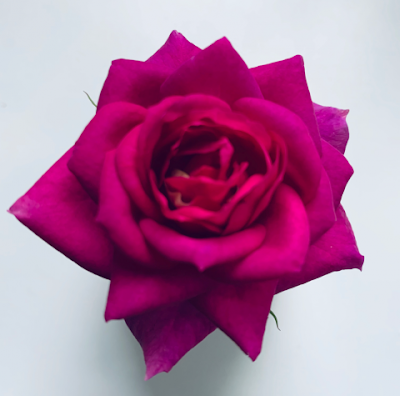This Professor from Tamil Nadu was acclaimed by the TIME magazine as one of the twenty most influential Asians of the 20th century and one of the only three from India, the other two being Mahatma Gandhi and Rabindranath Tagore. What is understood when you send a single Rose to someone ?
ரோஜா கவிஞர்களின் பூ ! சந்திரனுக்கே சவால் விடும் அளவு காதலுடன் சம்பந்தம் உள்ளது. பூ வாடிவிடும் சந்திரன் பிறையாக தேயும் ஆனால் காதல் என்றும் பூத்து வளர் பிறையாகும் என ஒரு கவிஞன் (வேறு யார் ??) எழுதியுள்ளான்.
இதோ இங்கே மற்றுமொரு புதிய ரோசாப்பூ ! இந்த புதிய ரோஜா வகையானது ஊதா நிறத்துடன் ஊக்கமளிக்கும் நறுமணத்துடன் கூடிய நோய் எதிர்ப்பு சக்தி கொண்டதாகும். இந்த ரோஜா செடி 4 முதல் 5 அடி வரை வளரும். கரும் பச்சையுடன் கூடி பெரிய இலைகளுடன் இந்த செடி காணப்படும். இந்த புதிய வகை ரோஜா செடி, மற்றொரு புதிய வகை ரோஜா செடியான மோன்கொம்பு ரோஜா செடி ஆகியவற்றை புதுடெல்லியைச் சேர்ந்த மலர் வளர்ப்பு விஞ்ஞானியும், மத்திய அரசின் தோட்டக்கலைத்துறை முன்னாள் இயக்குனருமான நரேந்திர தத்லானி, சென்னையில் உள்ள எம்.எஸ்.சுவாமிநாதன் இல்லத்தில் அவரை சந்தித்து வழங்கினார்.
They are beautiful .. .. though there could be hundreds of variants, most common is a ‘Red Rose’ but can one imagine them being associated with wars and brutal killings !! A rose is a woody perennial flowering plant of the genus Rosa, in the family Rosaceae, or the flower it bears.There are over three hundred species and tens of thousands of cultivars. They form a group of plants that can be erect shrubs, climbing, or trailing, with stems that are often armed with sharp prickles. Flowers vary in size and shape and are usually large and showy, in colours ranging from white through yellows and reds. The Wars of the Roses were a series of English civil wars for control of the throne of England fought between supporters of two rival cadet branches of the royal House of Plantagenet: the House of Lancaster, represented by a red rose, and the House of York, represented by a white rose. Eventually, the wars eliminated the male lines of both families.
Today comes the news that a new rose variety has been named after the
eminent agriculture scientist MS Swaminathan. The Rose is highly disease resistant with rich
magenta purple colour with stimulating aroma. Kodaikanal-based M.S.
Viraraghavan, India’s leading horticulturist and rose breeder, has bred and
named it as THE M.S. SWAMINATHAN ROSE, in the honour of Prof. Swaminathan –
father of India’s Green Revolution.
Prof. Swaminathan pioneered in bringing new approaches to the breeding of food crops which increased production and made India food self-sufficient. Mr. Viraraghavan bred more than 100 new varieties of roses registered in his name. THE M.S. SWAMINATHAN ROSE shrub grows up to 4-5 ft. with dark green granular surface large leaves with regular thorns. It results from a series of crosses with a ‘News’ variety of rose and other purple roses. A second new variety of rose named as “Jewel of Monkompu(JoM)” was bred by K. Sriram of Kasturirangan and Sriram, Bengaluru.
Dr. Narendra Dadlani, Floriculture Scientist and former Director Horticulture, Govt. of India, New Delhi, handed over the two varieties to Prof. Swaminathan at his Chennai residence. He also handed over a copy of his book – Indian Rose. “It is the first book on Indian Roses, its history and technical aspects of their development and description of Indian rose varieties” said Dr. Dadlani. (photo and excerpts from - https://www.mssrf.org/)
The man referred at the start is Professor M S Swaminathan. He has been described by the United Nations Environment Programme as "the Father of Economic Ecology" because of his leadership of the ever-green revolution movement in agriculture and by Javier Perez de Cuellar, Secretary General of the United Nations, as "a living legend who will go into the annals of history as a world scientist of rare distinction". He was Chairman of the UN Science Advisory Committee set up in 1980 to take follow-up action on the Vienna Plan of Action. Besides very many International posts, he served as Director of the Indian Agricultural Research Institute (1961-72), Director General of Indian Council of Agricultural Research and Secretary to the Government of India, Department of Agricultural Research and Education (1972-79), Principal Secretary, Ministry of Agriculture (1979-80), Acting Deputy Chairman and later Member (Science and Agriculture), Planning Commission (1980-82) and Director General, International Rice Research Institute, the Philippines (1982-88).
A plant geneticist by training, Professor Swaminathan's contributions to the agricultural renaissance of India have led to his being widely referred to as the scientific leader of the green revolution movement. His advocacy of sustainable agriculture leading to an ever-green revolution makes him an acknowledged world leader in the field of sustainable food security. Professor Swaminathan was awarded the Ramon Magsaysay Award for Community Leadership in 1971, the Albert Einstein World Science Award in 1986, the first World Food Prize in 1987, and Volvo, Tyler and UNEP Sasakawa Prize for Environment, the Indira Gandhi Prize for Peace, Disarmament and Development in 2000 and the Franklin D Roosevelt Four Freedoms Medal, the Mahatma Gandhi Prize of UNESCO in 2000 and the Lal Bahadur Sastri National Award (2007). He is the recipient of Padma Shri (1967), Padma Bhushan (1972) and Padma Vibushan (1989).
The beautiful rose featured here is from my terrace !!
With regards – S. Sampathkumar
25th Dec 2021


No comments:
Post a Comment